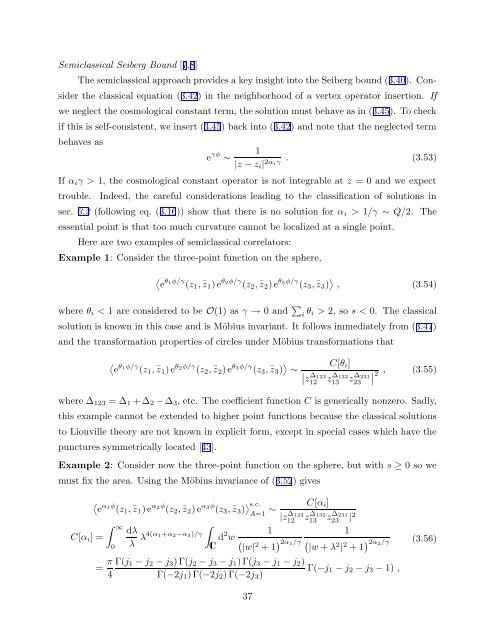arXiv:hep-th/9304011 v1 Apr 5 1993
arXiv:hep-th/9304011 v1 Apr 5 1993
arXiv:hep-th/9304011 v1 Apr 5 1993
You also want an ePaper? Increase the reach of your titles
YUMPU automatically turns print PDFs into web optimized ePapers that Google loves.
Semiclassical Seiberg Bound [7,8]<br />
The semiclassical approach provides a key insight into <strong>th</strong>e Seiberg bound (3.40). Consider<br />
<strong>th</strong>e classical equation (3.42) in <strong>th</strong>e neighborhood of a vertex operator insertion. If<br />
we neglect <strong>th</strong>e cosmological constant term, <strong>th</strong>e solution must behave as in (3.45). To check<br />
if <strong>th</strong>is is self-consistent, we insert (3.45) back into (3.42) and note <strong>th</strong>at <strong>th</strong>e neglected term<br />
behaves as<br />
e γφ ∼<br />
1<br />
|z − z i | 2α iγ . (3.53)<br />
If α i γ > 1, <strong>th</strong>e cosmological constant operator is not integrable at z = 0 and we expect<br />
trouble.<br />
Indeed, <strong>th</strong>e careful considerations leading to <strong>th</strong>e classification of solutions in<br />
sec. 3.2 (following eq. (3.16)) show <strong>th</strong>at <strong>th</strong>ere is no solution for α i > 1/γ ∼ Q/2. The<br />
essential point is <strong>th</strong>at too much curvature cannot be localized at a single point.<br />
Here are two examples of semiclassical correlators:<br />
Example 1: Consider <strong>th</strong>e <strong>th</strong>ree-point function on <strong>th</strong>e sphere,<br />
〈<br />
e<br />
θ 1 φ/γ (z 1 , ¯z 1 ) e θ 2φ/γ (z 2 , ¯z 2 ) e θ 3φ/γ (z 3 , ¯z 3 ) 〉 , (3.54)<br />
where θ i < 1 are considered to be O(1) as γ → 0 and ∑ i θ i > 2, so s < 0. The classical<br />
solution is known in <strong>th</strong>is case and is Möbius invariant. It follows immediately from (3.47)<br />
and <strong>th</strong>e transformation properties of circles under Möbius transformations <strong>th</strong>at<br />
〈<br />
e<br />
θ 1 φ/γ (z 1 , ¯z 1 ) e θ2φ/γ (z 2 , ¯z 2 ) e θ3φ/γ (z 3 , ¯z 3 ) 〉 C[θ i ]<br />
∼ ∣<br />
∣z ∆ 123<br />
12<br />
z ∆ 132<br />
13<br />
z ∆ 231<br />
23<br />
∣ 2 , (3.55)<br />
where ∆ 123 = ∆ 1 + ∆ 2 − ∆ 3 , etc. The coefficient function C is generically nonzero. Sadly,<br />
<strong>th</strong>is example cannot be extended to higher point functions because <strong>th</strong>e classical solutions<br />
to Liouville <strong>th</strong>eory are not known in explicit form, except in special cases which have <strong>th</strong>e<br />
punctures symmetrically located [43].<br />
Example 2: Consider now <strong>th</strong>e <strong>th</strong>ree-point function on <strong>th</strong>e sphere, but wi<strong>th</strong> s ≥ 0 so we<br />
must fix <strong>th</strong>e area. Using <strong>th</strong>e Möbius invariance of (3.52) gives<br />
C[α i ] =<br />
〈<br />
e<br />
α 1 φ (z 1 , ¯z 1 ) e α2φ (z 2 , ¯z 2 ) e α3φ (z 3 , ¯z 3 ) 〉 s.c.<br />
∼ C[α i ]<br />
A=1<br />
|z ∆ 123<br />
∫ ∞<br />
∫<br />
dλ<br />
0 λ λ4(α 1+α 2 −α 3 )/γ<br />
1<br />
C d2 w (<br />
|w| 2 + 1 ) 2α 1 /γ<br />
= π 4<br />
Γ(j 1 − j 2 − j 3 ) Γ(j 2 − j 3 − j 1 ) Γ(j 3 − j 1 − j 2 )<br />
Γ(−2j 1 ) Γ(−2j 2 ) Γ(−2j 3 )<br />
12<br />
z ∆ 132<br />
13<br />
z ∆ 231<br />
23<br />
| 2<br />
1<br />
(<br />
|w + λ 2 | 2 + 1 ) 2α 2 /γ<br />
Γ(−j 1 − j 2 − j 3 − 1) ,<br />
(3.56)<br />
37
















